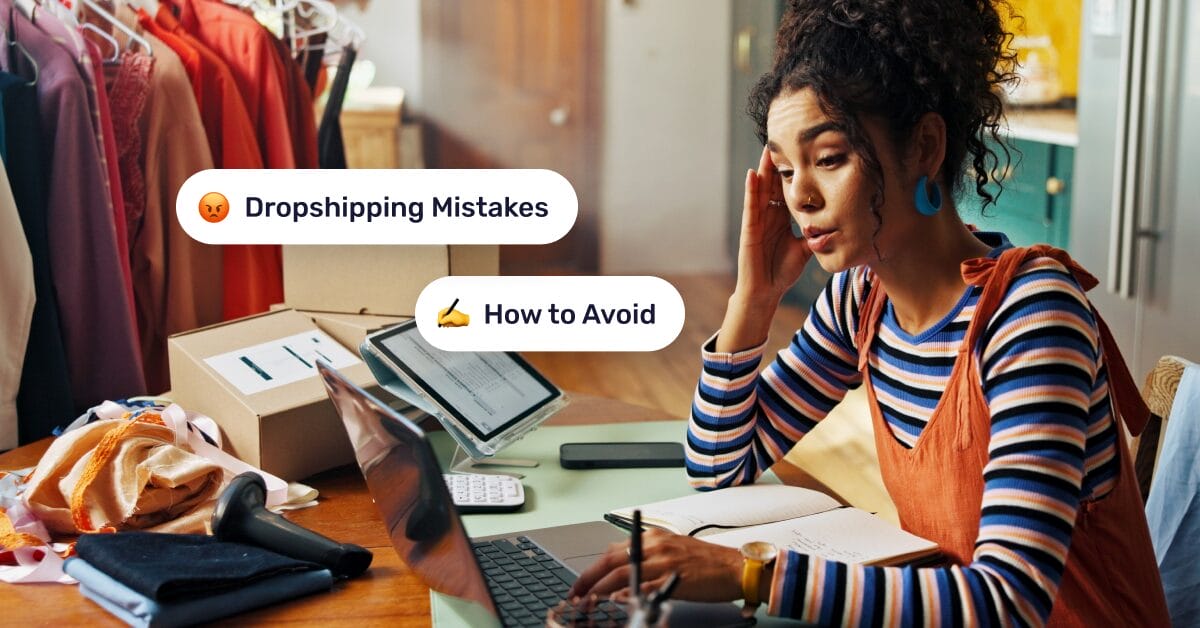Dropshipping might be simple from the outside. You know, pick a product, list it online, and wait for sales to roll in. And honestly? Once you understand how it works, it kind of is. But there’s a reason why so many dropshippers don’t make it after the first year. And it’s usually due to common errors that could totally be avoided.
In this article, we’ll break down the most common dropshipping mistakes beginners and experienced sellers make. And, mostly, we’ll share tactics to avoid them, practical insights, and smart automation strategies that can help you along the way.
For example, AutoDS automates every step of the dropshipping workflow to avoid potential errors, help you scale fast, and reduce manual inputs.
Most dropshipping failures come from avoidable mistakes. For example, poor product research, unreliable suppliers, and ignoring account health. Knowing what to watch for is half the battle.
Automation and AI can be powerful allies, but only if used strategically. Set clear rules, monitor results, and make sure your tools serve your goals (not the other way around).
Preparation beats perfection. Regular audits, backup suppliers, and proactive customer support help you prevent small issues from turning into major setbacks.
AutoDS helps you prevent mistakes with automation at every step of the dropshipping workflow, from sourcing to fulfillment.
Why is it Important To Know About Dropshipping Mistakes
Everyone wants to be a dropshipper these days. And it’s easy to see why. It promises a low upfront investment, flexible hours, and the chance to earn passive income from the comfort of your house. No inventory, no shipping, no office.
But reality is not as optimistic. It is estimated that only between 10% and 20% of dropshippers actually succeed within the first year (according to recent dropshipping statistics). And Shopify states that only 5%-10% of online stores are profitable.
Don’t be a part of that 90% that falls behind. With AutoDS, the all-in-one dropshipping platform, you get all the automation tools you need to be the 10% that succeeds 👉 Start your $1 trial today!
So, what happens along the way between the promise of an easy, profitable business and such a low success rate? A couple of things (that could totally be managed, but not everyone knows how). Now, there’s:
- …more competition. Before, only a few were doing it. The opportunities were endless. You had pretty much the whole online universe to yourself. But today, the market is more competitive than ever, with thousands of new sellers around the world.
- …more demands from shoppers. Now, they expect fast shipping, easy returns, high-quality items, and transparent communication.
- …more selling channels became available, each with its own rules, best practices, and algorithms.
The equation is simple: dropshipping has changed, and now it’s a bit harder to keep up with. The good news? It’s more accessible than ever. The not-so-good news? It’s easy to see why some may get lost along the way.
You have to stand out from the competition, find high-converting items, fulfill orders fast, partner with reliable suppliers, manage returns, and more. And that’s where mistakes can happen.
Luckily, it’s almost 2026. And there are multiple technologies that can help make everything easier, from AI and automation to customer experience tools. It’s not just about listing items anymore. It’s about staying competitive in a smarter, faster market.
The Most Common Dropshipping Mistakes
So, what common dropshipping mistakes can you make along the way? Let’s break them down.
Foundational Mistakes (Often Overlooked)
First, the basics. Those little things that one usually overlooks, thinking it’s not going to happen to them. Yeah, here’s the harsh truth: they probably will happen if you don’t pay attention. And, over time, they can become the roots leading to bigger problems. Let’s see:
Poor niche or market selection. The first thing you have to think about in dropshipping is this: who are you selling to? If you don’t know your audience, how can you know how to sell and who to target? The most common mistake when choosing your first product is selecting a niche that’s too broad, oversaturated, or has low demand. So, before you do anything else, research your market, understand it, and get to know it. And, mostly, make sure it’s actually profitable.
Lack of product validation. Not testing your product enough can lead to low conversions, a high return rate, chargebacks, or worse, no interest at all. Research how the product is performing, order a few samples, and check for reviews. Remember: your products are the heart of your dropshipping business.
Weak supplier vetting. You can have the best products, but if your suppliers don’t ship on time, change prices randomly, don’t respond to your messages, don’t take returns, and don’t update their listings, get ready for a dropshipping nightmare. An unreliable supply chain can kill your business. So make sure to choose your suppliers wisely.
Ignoring all costs. Dropshipping is not about reselling items just a little bit more expensive than the original product. There are hidden costs that influence the unit price, like shipping, returns, fees, taxes, marketing, tools, you name it. Therefore, when pricing your products, you need to factor in all potential costs. Otherwise, you’re just losing money.
Ignoring brand identity. Marketing matters. A lot. It’s how you stand out from the market, make shoppers remember you, and increase repeat buyers. So now, from any product page, you can launch the AutoDS Ad Text Generator with a single click to create your unique campaign copy based on your brand identity and tone. When someone is between two identical products, branding is the reason why they might choose you instead of the store next door. Ignoring this is a common mistake that impacts your business big time in the long run.
Operational And Execution Mistakes
Then, there are the things that happen in the heat of the moment while you’re juggling multiple tasks at once. Things you might overlook because they get lost in the millions of things going on at once in the dropshipping workflow. For example:
Relying on just one supplier. You know what they say: never put all your eggs in one basket. And they’re right. If you only have one supplier, you don’t have a plan B when they run out of stock, forget to update a listing, or suddenly raise prices at the last minute. If you want to protect your relationship with customers and your margins, always have a backup.
Underestimating shipping times. Shipping and delivery take time. You have to fulfill the order, the order request has to reach the supplier, the supplier has to ship it, and then, a few days later, it finally arrives at the destination. If something happens during this process, everything gets delayed. The outcome? An upset customer, a return, or worse, a chargeback. While you’re not in control of most of this process, you are in control of fulfillment. So get started quickly.
Not optimizing your listings. Poor titles, vague descriptions, and blurry images won’t bring sales. Each listing needs optimization, from SEO-friendly copies to high-performing images. When you miss this step, you’re also missing out on traffic, clicks, and conversions.
Constantly cutting prices. Yes, there are dozens of other stores selling the same items as yours. And yes, their prices may be lower. But getting into a price war and constantly undercutting prices is useless. The only thing you will get is $0 in margins. Plan a smart, strategic pricing strategy and stick to it. If it makes sense, it will work.
Ignoring customer service. Helping shoppers and communicating clearly is the ABC of running a professional business. If you don’t, expect to deal with angry customers, returns, bad reviews, and chargebacks. All things that can hurt your business big time if you don’t fix them soon.
Poor handling of returns, refunds, and disputes. Nobody likes returns. Not you, not the customer. But it comes with the e-commerce life, and you have to be ready to deal with it. If you don’t do it right, get ready for chargebacks and disputes, which are way harder to handle than a typical, friendly refund. Make sure your suppliers take returns, provide clear policies, and manage them quickly so customers don’t get anxious.
Automation & Tools Mistakes (Especially in 2025)
In 2025, everyone is obsessed with their tech stack. They’re implementing AI, automation, data analytics, and so on. And while that is a really good thing, not everyone knows how to do it right.
Tech can be a great ally, but it needs to be aligned with your goals. Otherwise, it’s just a complicated task that slows you down instead of helping you scale. Let’s see some mistakes to avoid and do it right:
Using automation blindly. Automation makes things easier and quicker. But it’s not about automating everything just because. Some things need a bit of a human touch, like responding to a customer complaint or managing supplier relationships.
Not customizing automation rules. Automation is great, but not if you don’t set it up right. If you don’t understand what you’re automating, this can lead to pricing errors, inventory mismatches, updates that you didn’t approve, and poor customer experiences. Automation is like a car driving on autopilot, sure. But you need to set at least the direction in which it’s heading.
🆕 Beginner’s Tip: Automate with intention. Don’t turn on every automation feature right from the start. Start with the essentials, like stock monitoring and order fulfillment. Then, expand once you understand how each setting affects your store’s performance.
Failing to monitor stock and price changes in real time. Tech is supposed to be there for the things you can’t do (or that you can, but would become a full-time job if you had to do them). Monitoring price and stock is one of those things, especially as your catalog grows. You need to constantly check suppliers’ listings to make sure yours are correct. And that’s where automation shines.
Letting duplicates or conflicting listings slip through. This confuses shoppers, hurts syour store’s SEO, wastes ad spend, and makes your brand look unprofessional. Check your listings, optimize them, and make sure they are not eating each other’s traffic.
Not tracking your performance. The great thing about selling online? Data. Tons of it. Use it to make smarter decisions, better know your customers, and see what sells (and what doesn’t). If you’re not paying attention to it, you’re missing out big time.
Risk & Compliance Mistakes
This is where things might seem a little boring, but it’s also where mistakes can cost you the most: compliance, yay! (said no one ever). Here’s what to avoid:
Violating marketplace terms. Dropshipping 101: Always read the policies. Every platform, like Amazon, eBay, or TikTok Shop, has strict guidelines on dropshipping, product sourcing, delivery times, categories, and so on. If you break them, your account could be banned in seconds (literally). So, general rule of thumb? Just make sure you know their rules and comply with them.
Neglecting your account health. You know that episode in Black Mirror where people are scored based on their behavior? Well, in dropshipping, that isn’t so dystopian—it’s reality. Marketplaces constantly track your performance as a seller. They even have specific metrics to keep track of this, such as return rates, late shipments, and DSRs (Detailed Seller Ratings).
A low score can lead to lower visibility, higher fees, or even an account suspension. Avoiding this isn’t so hard, really. Just do the basics: keep orders accurate, respond to messages on time, and comply with delivery timelines.
Mismanaging payments. Failing to monitor how much money comes in and out can become a mess. Transaction fees, refunds, and chargebacks all impact your margins. And if you don’t track them, you could face delayed or frozen payouts from platforms. Also, many sellers forget to factor in supplier costs with sales revenue, which leads to cash flow gaps and confusion. In short, just keep your finances in order to protect your entire operation.
IP infringement and counterfeit issues. If you’re in dropshipping, this is the first thing you should know and never forget: you can’t sell branded products without authorization. Also, you can’t use copyrighted items, like images or videos, that you don’t have permission to use. Platforms like Amazon and eBay automatically flag IP violations. And be careful: even one strike can suspend your account. Always make sure your supplier is authorized and avoid lookalike items.
Ignoring tax and regulatory requirements. Skipping VAT registration, import duties, or customs declarations can lead to fines, shipment delays, or even account restrictions. And this is especially true when selling across borders. Always make sure you’re complying with all regulations in your country and your shoppers’ regions.
🆕 Beginner’s Tip: Document everything. Keep clear records of your supplier communications, refunds, and policy updates. When problems come up (because eventually, they will), having everything “on paper” makes resolving issues faster and protects your accounts from unnecessary penalties.
Recovery And Prevention Strategies
Dropshipping mistakes can happen to anyone. But the difference between a beginner and an experienced dropshipper is how they handle them. The key? Catching them early and building strategies that prevent them from happening again.
Here are some extra tricks to avoid the previous mistakes. These are all tactics that will strengthen your processes and protect your business in the long term.
Audit existing operations periodically. Every once in a while, make sure to check your entire business. Check on your listings, suppliers, pricing rules, and fulfillment performance. A simple audit can help you spot hidden issues and improvements before they add up and become a bigger problem.
Test before scaling. Don’t launch everything at once. Start with small batches or split tests. This helps you identify which products actually sell, which don’t, and which listings are performing better in terms of SEO, clicks, and conversions. This way, you can optimize as you go.
Measure and centralize. Make sure you’re tracking everything with alerts and key metrics. Also, try to centralize your operations in simple, unified dashboards. The goal is to have visibility to see how everything is going. You can do this on a spreadsheet, but there are dropshipping tools like AutoDS that provide advanced, automated dashboards.
Invest early in customer support. Good support is everything. It’s what makes people trust your store and come back for more. Quick, honest replies go a long way. They show you actually care. You can automate basic questions to stay responsive 24/7, but when things get sensitive, it’s better to add a human touch to handle the issue.
Use automation tools smartly. Automation can save hours, but only if it’s done right. Double-check pricing rules, fulfillment settings, and stock syncs. This way, you make sure your tech stack is actually aligned with your goals (not killing them).
How AutoDS Helps You Avoid Dropshipping Mistakes
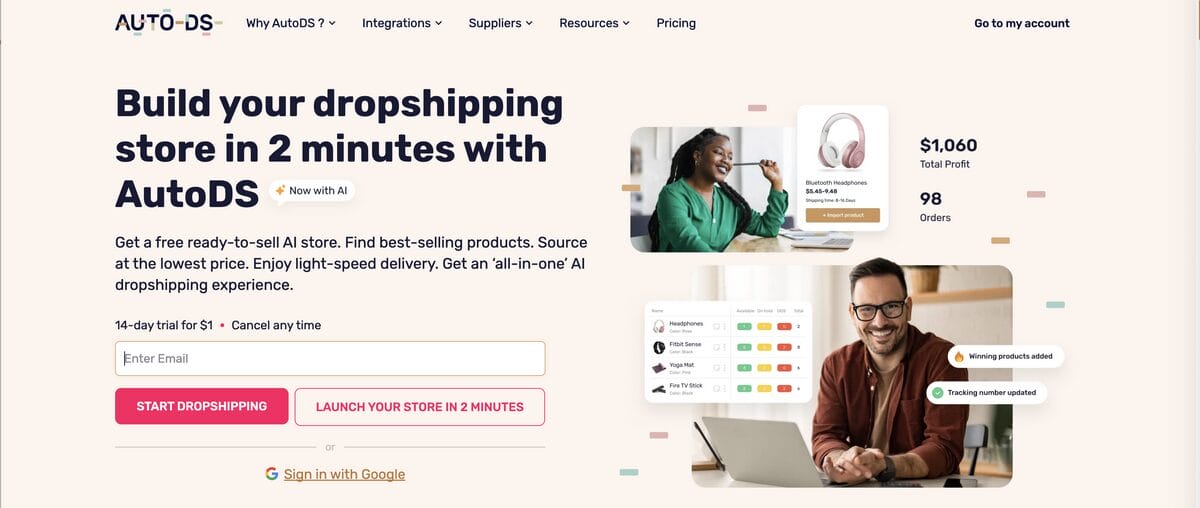
We’ve said this before: mistakes can happen to anyone. But if you’re doing everything manually, there are more chances of missing something, misspelling a customer’s address, duplicating a listing, or setting the wrong price on a product.
That’s where dropshipping platforms with automation make all the difference. By cutting down on manual inputs, they reduce (costly) mistakes and allow your business to run on autopilot.
AutoDS provides automation at every step of the dropshipping workflow, from sourcing to returns and everything in between. Let’s zoom in:
Product research tools. AutoDS offers a marketplace, a trending product hub, and a hand-picked selection of products based on real-time performance data. This way, you don’t have to guess which products will perform the best. You just get everything sorted out for you.
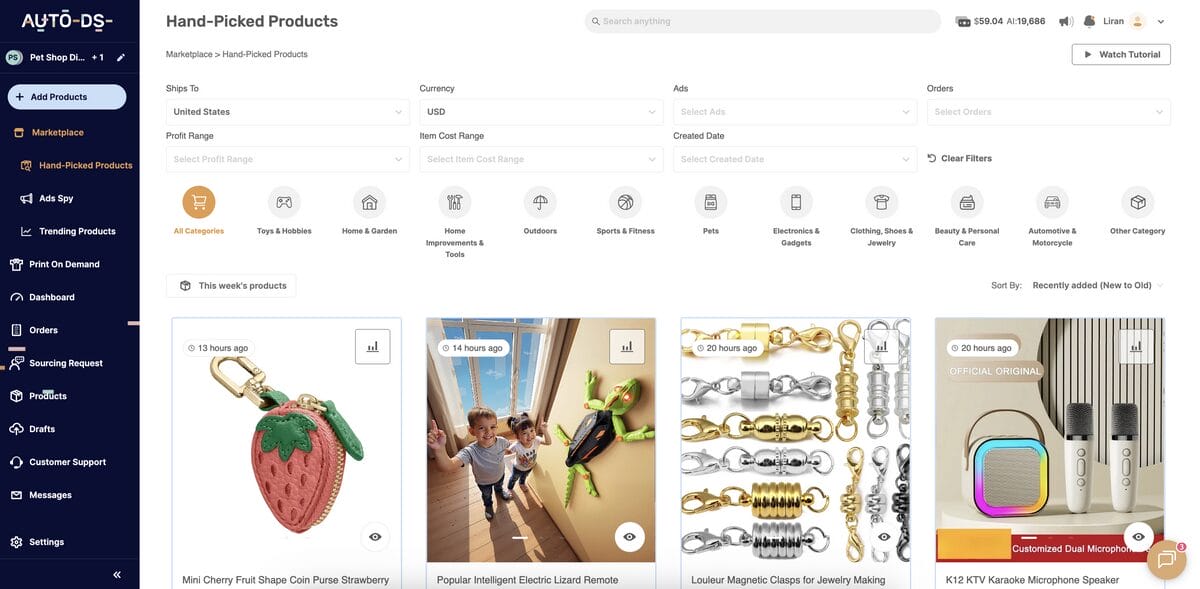
Stock and price monitoring. One of the most challenging things in dropshipping is making sure your listings align with your suppliers. If one of them changes prices, you need to adjust yours. If not, you’re just losing money. Or, worse, if one of them runs out of stock, you need to make sure your store is not still offering that. Otherwise, get ready for an angry customer and a refund.
AutoDS solves this with 24/7 automated stock and price monitoring. It checks your suppliers’ listings and, then, automatically updates yours.
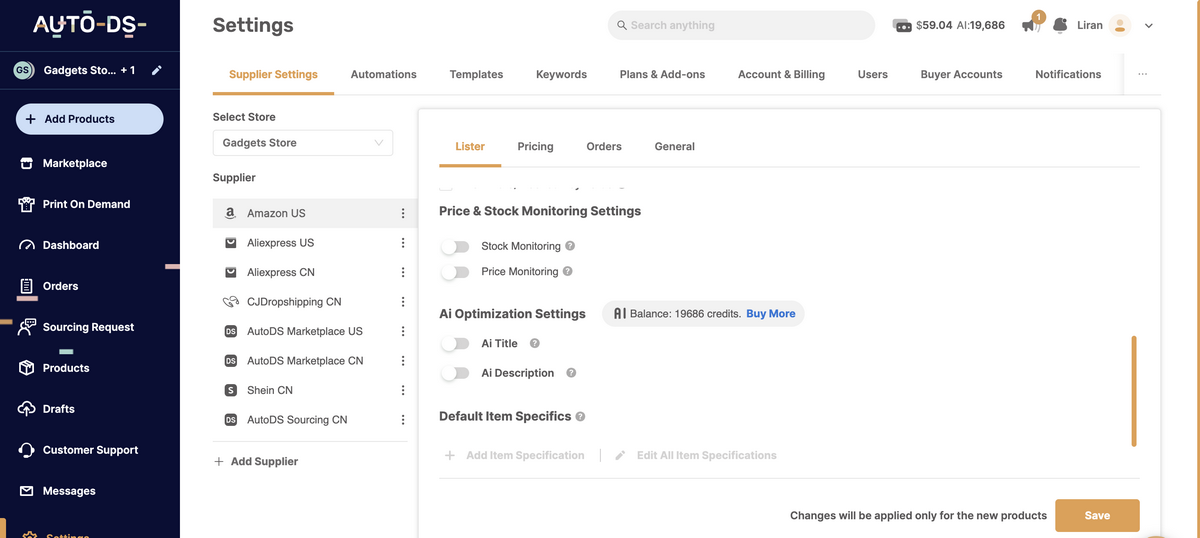
Bulk product importing. Manual importing usually takes a lot of time. You have to copy and paste every single detail, which can be a burden if your catalog is growing. AutoDS lets you bulk import products from multiple suppliers at once. You just copy and paste the original URL, and the system pulls everything in, from titles and descriptions to images and variations. This way, you speed up listing without potential mistakes.

Automated fulfillment. Another area where major (and by major, we mean really, absolutely big) mistakes can happen. A wrong letter or number, and your customer’s order can go to the other side of the world. You don’t want that.
AutoDS fulfills orders automatically, so there’s no copy-pasting involved. Moreover, Fulfilled by AutoDS doesn’t even use your own seller accounts, preventing compliance mistakes.

Analytics dashboard and alerts. AutoDS centralizes everything for you in one single place. You can spot performance metrics, real-time order status, and even manage returns automatically. This way, you don’t have everything spread across dozens of spreadsheets. Plus, its order dashboard makes sure there are no duplicate listings.
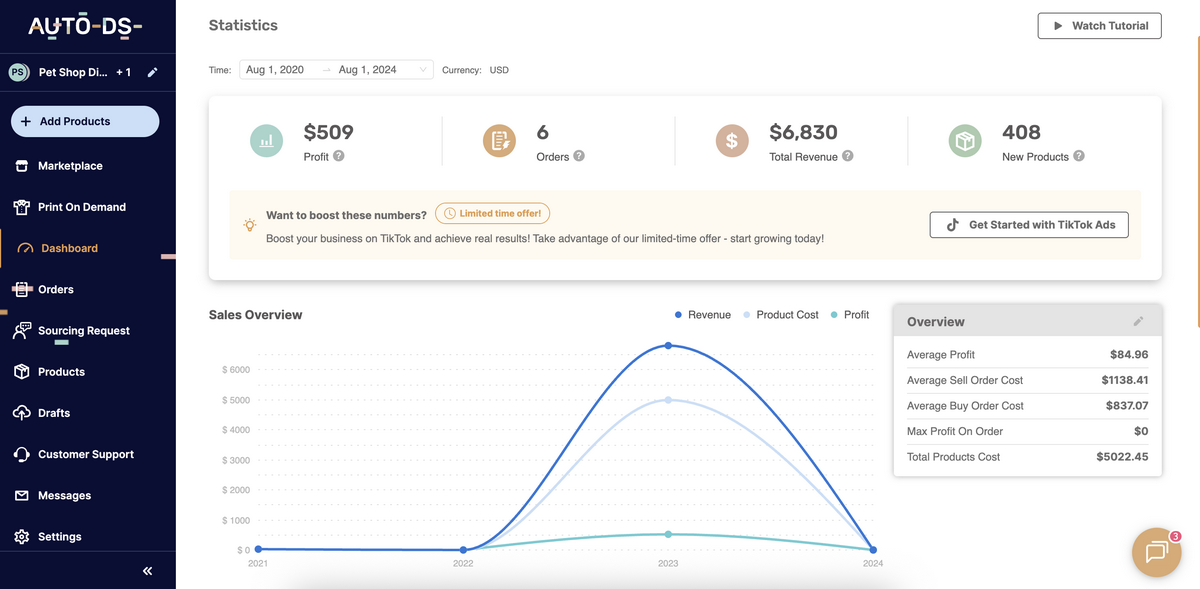
Integrations across platforms. Thanks to its integrations with the most important selling channels (like eBay, Amazon, Shopify, TikTok Shop, and more), AutoDS keeps all your operations synced in real time. In other words, you can manage multiple stores from one place at once. That means fewer manual updates, fewer errors, and no juggling multiple dashboards.
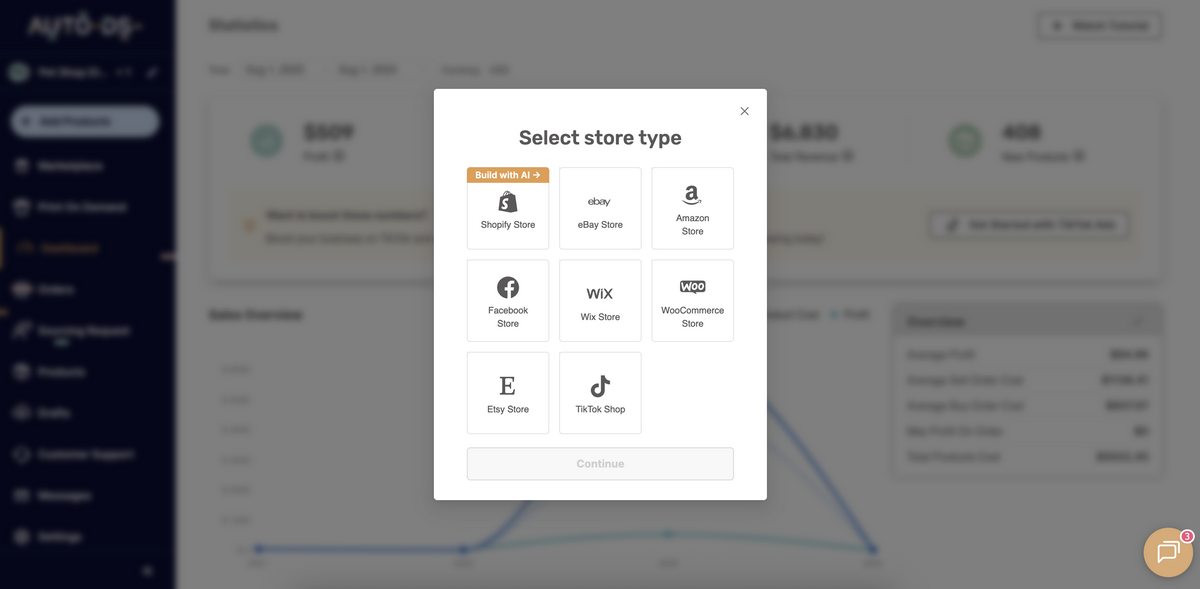
AI listing optimization. AutoDS automates copywriting with its AI Product title & description generator. You just pick the tone you want, and it creates high-converting copies for your listings. No more keyword research on your end or titles that don’t drive clicks.
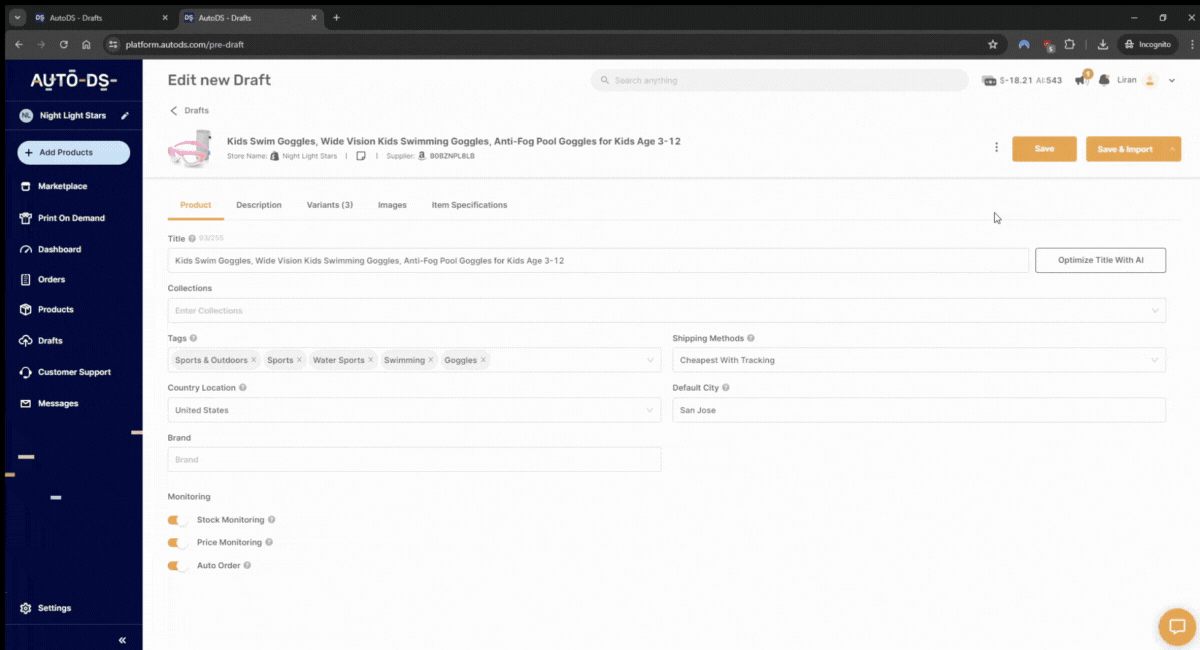
Frequently Asked Questions
Which mistake causes the most dropshipping failures in 2025?
A common mistake that causes the most dropshipping failures in 2025 is supplier unreliability and stock issues. If your product is “out of stock” or is delayed frequently, it destroys customer trust and your seller metrics.
Can automation tools like AutoDS fully eliminate dropshipping errors?
While no tool can guarantee to fully eliminate errors, automation platforms like AutoDS can drastically reduce human errors (like forgetting to update stock or price). That said, you still need to do manual checks and plan your strategy. As a general rule of thumb, complement automation with periodic audits.
How early should I invest in branding and positioning?
Invest in branding and positioning as early as possible. Even if you start with a small catalog, having consistent branding, packaging expectations, and messaging from day one helps you stand out from the crowd and build a loyal customer base.
What’s the best way to recover from a dropshipping mistake (e.g., high return rate or account health issues)?
To recover from a dropshipping mistake, first pause scaling and audit the root cause (supplier, listing, refund policy, you name it). Then, communicate with affected customers and offer solutions. Continue fixing the issue, either use a new supplier, optimize your listings, or improve quality checks. Lastly, monitor metrics closely as you get back on track and use automation and alerts to prevent future mistakes.
Start Your Dropshipping Journey with AutoDS
As a general takeaway of this article, we have good and bad news. The bad one? Mistakes will probably happen at some point. But the good news? If you know how to handle it and prevent it from happening again, you’re good to go. The key is having a plan, a strategy, and a tech stack that minimizes as many errors as possible.
AutoDS helps you reduce potential dropshipping mistakes by automating every step of the workflow, from sourcing your items to fulfilling your orders and everything in between.
With real-time market data, 24/7 stock and price monitoring, automatic pricing rules, automated fulfillment and returns, AI listing optimization, and automatic importing, you are free from the manual inputs to focus less on repetitive tasks and more on strategy and scaling.
And if you want to become a pro at dropshipping, here are some helpful reads you might find useful:






